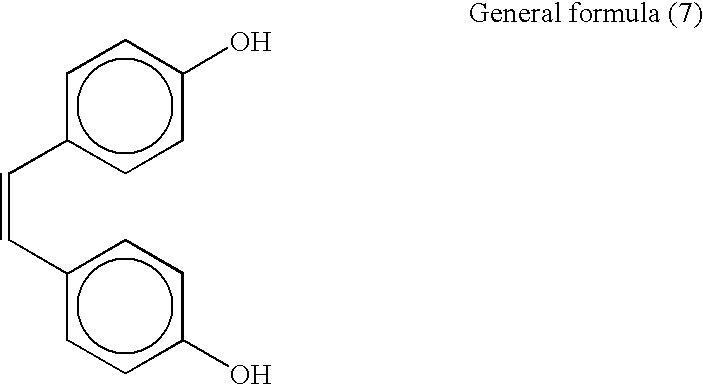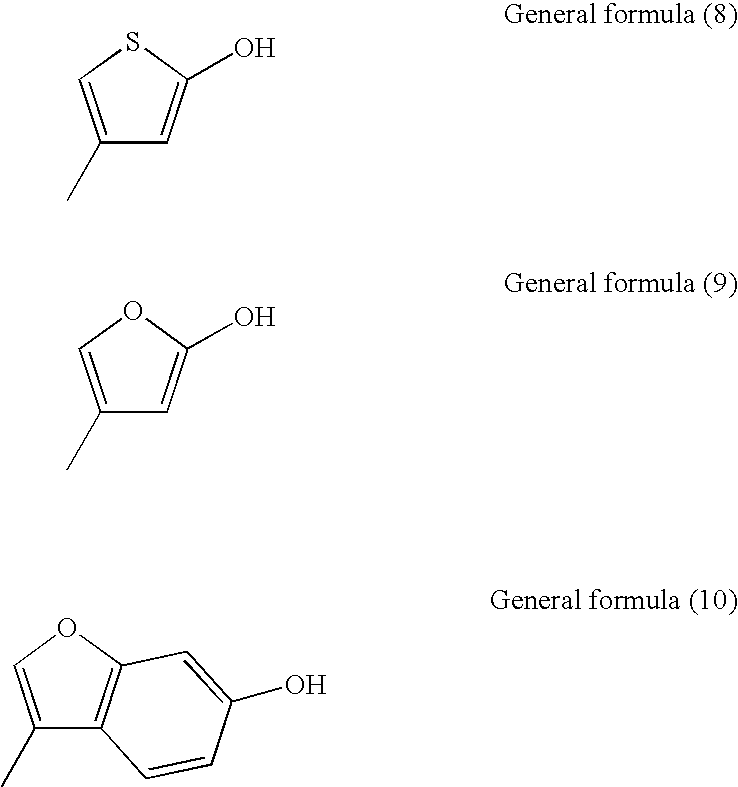Allergen-inhibiting method, allergen-inhibiting fiber and allergen-inhibiting sheet
a technology of allergens and fibers, applied in the field of allergen inhibitors, can solve the problems of high allergen stability, inability to fundamentally solve the allergic disease caused by dermatophagoide allergens, and inability to effectively inhibit allergens, etc., and achieve excellent allergen inhibition
- Summary
- Abstract
- Description
- Claims
- Application Information
AI Technical Summary
Benefits of technology
Problems solved by technology
Method used
Image
Examples
embodiments
Examples 1 to 7
[0156]Poly-4-vinyl phenol (weight-average molecular weight (Mw) 8000, manufactured by Aldrich), poly-4-vinyl phenol (poly-p-vinyl phenol) (Mw 20000, manufactured by Aldrich), or poly-L-tyrosine (Mw 15000 to 36000, manufactured by ICN Biomedicals) was used as the allergen inhibitor, and ethyl alcohol and ion-exchanged water were used as the solvent to prepare allergen inhibitor solutions. The resulting allergen inhibitor solution was introduced into a trigger-type spray container (about 0.8 ml spray by spraying once). The amounts of the allergen inhibitor and the solvent used are shown in Table 1.
examples 8 to 19
[0157]Sodium carbonate (Wako Pure Chemical Industries, Ltd.), potassium carbonate, sodium bicarbonate, alum (aluminum potassium sulfate (food additive) manufactured by Wako Pure Chemical Industries, Ltd.), sodium lauryl sulfate (Wako Pure Chemical Industries, Ltd.), lauryl sulfate triethanol amine (Kao Corporation), sodium lauryl benzene sulfonate (Wako Pure Chemical Industries, Ltd.) or sodium polyoxyethylene lauryl ether sulfate (Kao Corporation) was used as the allergen inhibitor, and ion-exchanged water was used as the solvent to prepare allergen inhibitor solutions. The resulting allergen inhibitor solution was introduced into a trigger-type spray container (about 0.8 ml spray by spraying once). The amounts of the allergen inhibitor and the solvent used are shown in Table 1. In Example 12, however, the amount of sodium carbonate used was 1.5% by weight, and the amount of sodium bicarbonate was 1.5% by weight.
examples 20 to 28
[0158]Zinc sulfate.7H2O (Wako Pure Chemical Industries, Ltd.), lead(II) acetate.2H2O (Wako Pure Chemical Industries, Ltd.), a phosphate buffer (pH 7.35) at a concentration of 0.01 M prepared by dissolving phosphates i.e. 0.01 M monosodium phosphate.2H2O (Kanto Kagaku) and 0.01 M disodium phosphate.12H2O (Wako Pure Chemical Industries, Ltd.) in ion-exchanged water and a phosphate buffer (pH 7.35) at a concentration of 0.001 M prepared by dissolving phosphates i.e. 0.001 M monosodium phosphate.2H2O (Kanto Kagaku) and 0.001 M disodium phosphate.12H2O (Wako Pure Chemical Industries, Ltd.) in ion-exchanged water were used to produce allergen inhibitor solutions. The resulting allergen inhibitor solution was introduced into a trigger-type spray container (about 0.8 ml spray by spraying once). The amounts of the starting materials used are shown in Table 1.
PUM
| Property | Measurement | Unit |
|---|---|---|
| molecular weight | aaaaa | aaaaa |
| molecular weight | aaaaa | aaaaa |
| weight | aaaaa | aaaaa |
Abstract
Description
Claims
Application Information
 Login to View More
Login to View More - R&D
- Intellectual Property
- Life Sciences
- Materials
- Tech Scout
- Unparalleled Data Quality
- Higher Quality Content
- 60% Fewer Hallucinations
Browse by: Latest US Patents, China's latest patents, Technical Efficacy Thesaurus, Application Domain, Technology Topic, Popular Technical Reports.
© 2025 PatSnap. All rights reserved.Legal|Privacy policy|Modern Slavery Act Transparency Statement|Sitemap|About US| Contact US: help@patsnap.com



